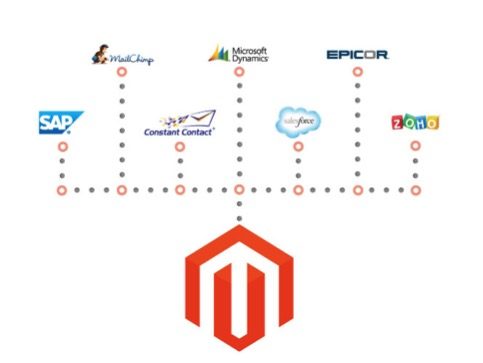Magento has enabled several businesses to bring their stores online with its amazing built-in features and a vast list of extensions.
Close to 2,50,000 websites are powered by Magento Commerce Platform, the most popular being Land Rover, Wrangler, Lee, and Made.com
Online storefronts built on Magento 2 platform are equipped with all the capabilities to generate enhanced sales and revenues for the business.
But that’s just the surface of the ocean. To be a successful ecommerce business, a well-designed storefront needs a solid and robust backend.
The backend systems like ERP/CRM go a long way in ensuring that the buying experience to the shoppers is seamless.
As an ecommerce business owner, it is important that you ensure that the payment completion is instantly followed by the order confirmation along with the order id to enable customers to track their purchase.
Also, your ecommerce storefront should be aware of the inventory status to ensure the payment is captured only when the availability of the product is confirmed.

Source– Best free web resources
There are several such scenarios that need to be taken care of, in order to provide a smooth and delightful shopping experience.
Magento 2 ERP integration solves most of these problems, provided due diligence has been exercised during the process of integration.
When done right, the Magento 2 ERP integration ensures that the entire experience of the buyers on Magento shopping website or app goes several notches higher.
Magento ERP integration brings in a slew of benefits:
- No delay in the exchange of data from Magento 2 to ERP system to expedite order processing and delivery.
- No discrepancy in the stock count ensures your storefront is updated about the stock in real-time.
- The customer always receives the right product as the processes and workflows are automated.
- The logistics is also optimized resulting in cost-efficient operations.
In order to provide a smooth order fulfilment of the customers, the data flow between your ERP/CRM and Magento platform should be seamless. A flawless Magento-ERP integration can alone ensure this.
The complexity of Magento ERP integration can be overwhelming depending on the size and nature of the storefront.
Enlisted here are some best practices to follow during the Magento ERP integration.
- Be clear about your expectations: Rather than following the trend, it is advisable to have your expectations clear from Magento 2 ERP integration.
- Be specific about the data to be shared: The data that is transferred to the ERP from Magento platform needs to be identified on the onset.
- Getting the Timing and Triggering Right: The data-flow between Magento and ERP system triggers different processes. For instance, after the payment has been processed, the ERP system must get the order details so that it generates an order Id and sends it back to Magento, which in turn could include it in the emails and other communications.
- Address the Middleware Requirement: The need for a third component in the Magento-ERP association arises in the case of multi-channel selling.
- End-user Experience: The customers must not have the slightest idea that an ERP or CRM is behind the storefront.
Whether it is the bringing down of the cost or to scale up the business or retaining the customers, the objectives must be clearly drawn out. The expectations thus set will form the basis of other best practices that we will discuss further.
In addition to the product, order and inventory data, your business may also require customer’s information to be stored in the CRM or ERP as well.The customers’ data may include the shipping addresses, contact information and purchase history to name a few.
A 2-way data transfer is always recommended between the ERP and Magento, however, the primary source of data that actually has the right to own and store the information needs to be identified.
Without this fundamental understanding, the entire integration process may prove to be unyielding.
A communication between ERP and Magento is also warranted before the payment is captured to ensure the availability of the product. This data exchange should be fast and seamless
The orders that are received from different channels including mobile apps require integration with the help of different APIs.
A middleware comes in handy in such multi-channel selling use-cases. It acts as a hub that makes the data-flow more streamlined.
From the security standpoint as well, a middleware is worth investing on. ConnectPoint is a widely used middleware in Magento ERP integration
The data transfer should be fast and seamless. If the ERP affects the experience of the users in an adverse manner, that means the integration still has some scope for improvement.
Final Remarks
Integration of Magento 2 with your preferred ERP or CRM system positively impacts the productivity as well as the efficiency of the process.
The seamless flow of data across the business ensures that large volumes of low-priced SKUs’ are handled well and customer service is uninterrupted.
This way, you are able to maximize the ROI on Magento as well as the ERP/CRM system. The best practices enlisted above can be helpful in helping you achieve your business goals.


